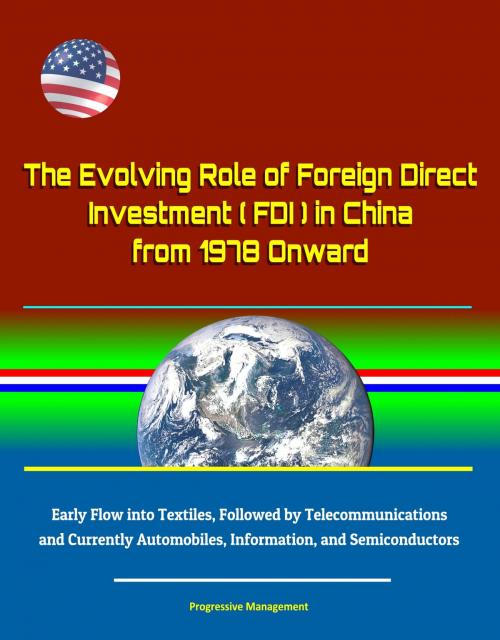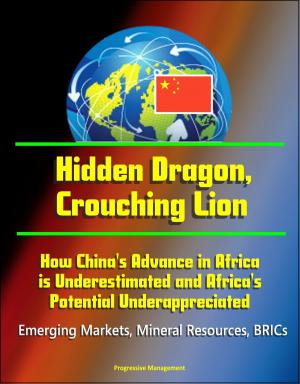The Evolving Role of Foreign Direct Investment (FDI) in China from 1978 Onward - Early Flow into Textiles, Followed by Telecommunications and Currently Automobiles, Information, and Semiconductors
Business & Finance, Economics, International, Nonfiction, History, Asian, China| Author: | Progressive Management | ISBN: | 9780463641446 |
| Publisher: | Progressive Management | Publication: | June 16, 2018 |
| Imprint: | Smashwords Edition | Language: | English |
| Author: | Progressive Management |
| ISBN: | 9780463641446 |
| Publisher: | Progressive Management |
| Publication: | June 16, 2018 |
| Imprint: | Smashwords Edition |
| Language: | English |
This important report has been professionally converted for accurate flowing-text e-book format reproduction.
From 1978 to the present day, China has developed its economy through the strategic use of foreign direct investment (FDI). This thesis demonstrates how Chinese economic reforms since 1978 have led to an increase in FDI inflows and illustrates how the government channeled those FDI flows to prioritize a process of economic development evolving from low-skilled to high-skilled sectors of the economy, evidenced by the country's evolving export profile over time. Through the examination of three different time periods, this thesis shows how shifts in government policy affected the inflows of FDI and how the government channeled this FDI. Between 1978 and 1989, the Chinese government funneled resources into non-strategic sectors, such as the textile industry. From 1989 to 2001, China reoriented its resources toward strategic sectors, including telecommunications. Finally, from 2001 to the present, China shifted its focus toward high-value added sectors of the economy, including automobiles, information and communications technology (ICT), and semiconductors. Overall, between 1978 and the present day, FDI has increased dramatically, reflecting China's economic priorities. The Chinese government's decision to use FDI to promote high-value added sectors showcases its ambitious and strategic policymaking in the service of rapid and sustained economic success.
I. INTRODUCTION * A. SIGNIFICANCE OF THE RESEARCH QUESTION * B. LITERATURE REVIEW * 1. FDI Policy * 2. FDI Policy as Related to China * C. POTENTIAL EXPLANATIONS AND HYPOTHESES * D. RESEARCH DESIGN * E. THESIS OVERVIEW * II. FIRST TIME PERIOD: 1978 TO 1989 * A. MACROECONOMIC PICTURE * B. HOW GOVERNMENT POLICY ATTRACTED FDI * C. HOW FDI TRANSLATED INTO ECONOMIC PERFORMANCE * D. CHINESE GOVERNMENT FDI APPROACH IN THE 1980s * III. SECOND TIME PERIOD: 1989 TO 2001 * A. MACROECONOMIC PICTURE * B. HOW GOVERNMENT POLICY ATTRACTED FDI * C. HOW FDI TRANSLATED INTO ECONOMIC PERFORMANCE * 1. Textile Sector * 2. Telecommunications Sector * 3. Automotive Sector * D. CHINESE GOVERNMENT FDI APPROACH IN THE 1990s * IV. THIRD TIME PERIOD: 2001 TO PRESENT * A. MACROECONOMIC PICTURE * 1. Fiscal Reform * 2. Banking Reform and State-Owned Enterprises * B. HOW GOVERNMENT POLICY ATTRACTED FDI * C. HOW FDI TRANSLATED INTO ECONOMIC PERFORMANCE * 1. High-Technology and Automotive Sector * 2. Information and Communications Technology (ICT) Sector * 3. Semiconductor Manufacturing Sector * D. CHINESE GOVERNMENT FDI APPROACH IN THE 2000s * V. CONCLUSION * A. EVOLUTION OF GOVERNMENT POLICY AND FDI * B. FUTURE PROSPECTS
This important report has been professionally converted for accurate flowing-text e-book format reproduction.
From 1978 to the present day, China has developed its economy through the strategic use of foreign direct investment (FDI). This thesis demonstrates how Chinese economic reforms since 1978 have led to an increase in FDI inflows and illustrates how the government channeled those FDI flows to prioritize a process of economic development evolving from low-skilled to high-skilled sectors of the economy, evidenced by the country's evolving export profile over time. Through the examination of three different time periods, this thesis shows how shifts in government policy affected the inflows of FDI and how the government channeled this FDI. Between 1978 and 1989, the Chinese government funneled resources into non-strategic sectors, such as the textile industry. From 1989 to 2001, China reoriented its resources toward strategic sectors, including telecommunications. Finally, from 2001 to the present, China shifted its focus toward high-value added sectors of the economy, including automobiles, information and communications technology (ICT), and semiconductors. Overall, between 1978 and the present day, FDI has increased dramatically, reflecting China's economic priorities. The Chinese government's decision to use FDI to promote high-value added sectors showcases its ambitious and strategic policymaking in the service of rapid and sustained economic success.
I. INTRODUCTION * A. SIGNIFICANCE OF THE RESEARCH QUESTION * B. LITERATURE REVIEW * 1. FDI Policy * 2. FDI Policy as Related to China * C. POTENTIAL EXPLANATIONS AND HYPOTHESES * D. RESEARCH DESIGN * E. THESIS OVERVIEW * II. FIRST TIME PERIOD: 1978 TO 1989 * A. MACROECONOMIC PICTURE * B. HOW GOVERNMENT POLICY ATTRACTED FDI * C. HOW FDI TRANSLATED INTO ECONOMIC PERFORMANCE * D. CHINESE GOVERNMENT FDI APPROACH IN THE 1980s * III. SECOND TIME PERIOD: 1989 TO 2001 * A. MACROECONOMIC PICTURE * B. HOW GOVERNMENT POLICY ATTRACTED FDI * C. HOW FDI TRANSLATED INTO ECONOMIC PERFORMANCE * 1. Textile Sector * 2. Telecommunications Sector * 3. Automotive Sector * D. CHINESE GOVERNMENT FDI APPROACH IN THE 1990s * IV. THIRD TIME PERIOD: 2001 TO PRESENT * A. MACROECONOMIC PICTURE * 1. Fiscal Reform * 2. Banking Reform and State-Owned Enterprises * B. HOW GOVERNMENT POLICY ATTRACTED FDI * C. HOW FDI TRANSLATED INTO ECONOMIC PERFORMANCE * 1. High-Technology and Automotive Sector * 2. Information and Communications Technology (ICT) Sector * 3. Semiconductor Manufacturing Sector * D. CHINESE GOVERNMENT FDI APPROACH IN THE 2000s * V. CONCLUSION * A. EVOLUTION OF GOVERNMENT POLICY AND FDI * B. FUTURE PROSPECTS















